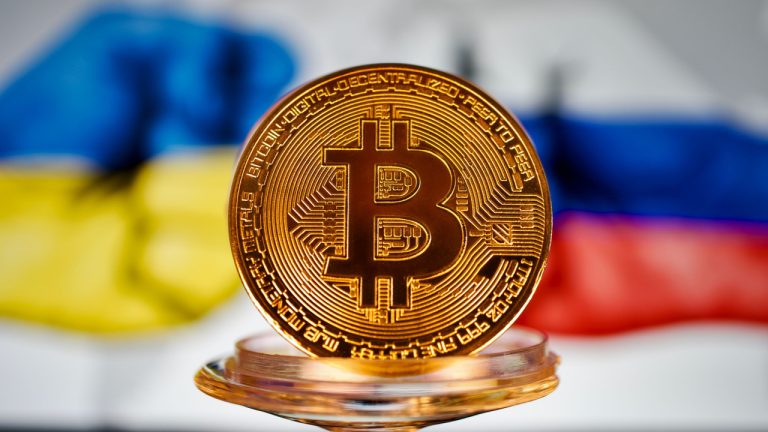 Authorities in Brussels are taking steps to reduce power consumption, including in cryptocurrency mining, as the EU faces limited energy supplies from Russia, the reliance on which it has been trying to lower. New energy efficiency labeling is to address the growing electricity usage in the crypto sector. EU to Develop Energy Efficiency Label for […]
Authorities in Brussels are taking steps to reduce power consumption, including in cryptocurrency mining, as the EU faces limited energy supplies from Russia, the reliance on which it has been trying to lower. New energy efficiency labeling is to address the growing electricity usage in the crypto sector. EU to Develop Energy Efficiency Label for […] Russians have been losing interest in Telegram channels devoted to cryptocurrencies and tokens, according to a new research covering the period since the start of the war in Ukraine. Industry experts behind the study say that bitcoin’s lower valuation and financial restrictions increasingly limiting access to the crypto market are the key reasons. Telegram Crypto […]
Russians have been losing interest in Telegram channels devoted to cryptocurrencies and tokens, according to a new research covering the period since the start of the war in Ukraine. Industry experts behind the study say that bitcoin’s lower valuation and financial restrictions increasingly limiting access to the crypto market are the key reasons. Telegram Crypto […] The deadly conflict that started with Russia’s assault on Ukraine has increased crypto-related activity in both countries, according to Chainalysis. Fiat inflation and sanctions pressure led to several spikes in transaction volumes this year, the blockchain forensics firm has found, while Eastern Europe as a whole sustained its role in the global crypto ecosystem. Russians […]
The deadly conflict that started with Russia’s assault on Ukraine has increased crypto-related activity in both countries, according to Chainalysis. Fiat inflation and sanctions pressure led to several spikes in transaction volumes this year, the blockchain forensics firm has found, while Eastern Europe as a whole sustained its role in the global crypto ecosystem. Russians […]
Consecutive all-time-high smart contract deployments and surging usage of Web3 script libraries mean that Web3 devs are still busy working despite the prolonged market downturn.
Web3 developers don’t appear to be fazed by the crypto bear market, with one Web3 platform suggesting they’re “more active than ever” — particularly on the Ethereum (ETH) network.
In a new Q3 2022 report on Oct. 13 by Web3 development platform Alchemy, the company said that 2022 could be the “biggest year yet” for Web3 developers.
Around 36% of all smart contracts ever deployed and verified on the blockchain have been in 2022, a count of nearly 118,000 compared to the over 323,700 ever deployed, according to the report.
This is despite the price of ETH falling by nearly 66% since the start of the year and the total value locked in decentralized finance (DeFi) protocols falling around 70% year-to-date according to DappRadar.
Nonfungible token (NFT) trading volumes have also taken a beating, decreasing by 98% since late January.
Alchemy states the deployment of smart contracts increased by 40% from the first quarter of the year with consecutive all-time highs hit every month over the third quarter peaking at 17,376 in September alone.

The data also shows smart contract deployments increased by 143% compared to the third quarter of 2021, reaching over 48,500 for the third quarter of 2022.
Alchemy noted that in the two weeks following Ethereum's Merge — when the blockchain moved from a proof-of-work to proof-of-stake consensus — smart contract deployment increased by 14% suggesting some developers may have been waiting for the event to launch their projects.
The company also analyzed the usage of two Web3 script libraries Ethers.js and Web3.js, which allow developers to read blockchain data and build Web3 products.
The team found the number of developers installing either library had increased by three times that of Q3 2021 to over 1.5 million downloads on average per week.
Related: Demand for talent in crypto less dependent on market as industry matures
Although some have claimed this current crypto bear market is a good time to build products in Web3 that hasn’t always been the case in previous cycles.
As evidenced in Alchemy’s data the 2017 to 2020 bear market saw a 45% decline in smart contract deployments in the middle of the cycle, from 2018 to 2019, although so far that metric has increased by 50% this year from 2021.

There are over 4,000 active DAOs, with treasuries totaling around $20 billion, which has many speculating that DAOs may still be a growing trend.
Decentralized autonomous organizations, or DAOs, have caught the imagination of many in the blockchain industry. What was once just a theory talked about on internet forums in the early days of the blockchain revolution has become a growing trend in how organizations form. Cointelegraph Research has unveiled a primer on DAOs, exploring their historical origins up through how they are currently impacting the cryptoverse.
There has been a massive spike in DAOs — or at least the modern conception of them — with over 4,000 active as of the latter half of 2022, according to data from Snapshot. Every cryptocurrency holder and investor can gain valuable insights from Cointelegraph Research’s “DAO: The Evolution of Organization” report to help understand where DAOs are in their evolution.
Download this report on the Cointelegraph Research Terminal.
The report seeks to understand what DAOs are, starting with the history of how the concept of a DAO began. The research identified the first era, DAO 1.0 — a time when DAOs were analog and lacked an overarching technology, which allowed for governance and efficient interaction. It started in academic business journals in the 1950s and 1960s, with the term first coined in 1997, 11 years before Satoshi Nakamoto’s Bitcoin (BTC) white paper appeared.
It can be argued that Bitcoin was the first modern DAO. The start of the blockchain revolution allowed for major advancements and the transition to the era of DAO 2.0 when on-chain governance was pioneered by Dash (DASH) in 2015. The modern era of DAO 3.0 truly exploded with the proliferation of tools and infrastructure to support efficiently setting up and running DAOs.
According to the Cointelegraph Research Venture Capital Database, while 40% of DAOs today focus on decentralized finance, many others have been created with focuses on social and political causes (15%); physical assets represented by digital tokens (such securitized housing), GameFi and nonfungible tokens (26%); and infrastructure and tooling (14%).

Many may wonder if it is better to hodl a DAO token or a coin from a layer-1 blockchain like Ethereum, on which many DAO protocols are built, for the best return on investment. Analyzing some of the largest DAO tokens by market capitalization from January 2021 through the summer of July 2022 shows some surprising results.
During the bull run, most of these DAO tokens outperformed Ether (ETH). However, only one, PancakeSwap’s CAKE (CAKE) token, stayed in the positive the entire period. While the past does not equal the future, there may be something to learn from this, as DAO tokens may rise faster during periods of extreme bullish sentiment — and fall further during bearish market tendencies as well.

Cointelegraph Research’s report walks readers through various case studies, including OlympusDAO, Coinshift and the 2016 hack on The DAO. The infamous attack resulted in the loss of over $60 million in funds and a hard fork that led to the appearance of two different blockchain protocols: Ethereum and Ethereum Classic. The report also presents tokenomics, governance and other key metrics to offer insights into how DAOs function today — and perhaps, what DAOs will look like in their 4.0 era.
Cointelegraph’s Research department comprises some of the best talents in the blockchain industry. Bringing together academic rigor and filtered through practical, hard-won experience, the researchers on the team are committed to bringing the most accurate, insightful content available on the market.
Demelza Hays, Ph.D., is the director of research at Cointelegraph. Hays has compiled a team of subject matter experts from across the fields of finance, economics and technology to bring to the market the premier source for industry reports and insightful analysis. The team utilizes APIs from a variety of sources in order to provide accurate, useful information and analyses.
With decades of combined experience in traditional finance, business, engineering, technology and research, the Cointelegraph Research team is perfectly positioned to put its combined talents to proper use with the “DAO: The Evolution of Organization” report.
The opinions expressed in the article are for general informational purposes only and are not intended to provide specific advice or recommendations for any individual or on any specific security or investment product.
 According to Dappradar’s latest crypto industry report that covers 2022’s third quarter, the crypto economy and its participants are “riding out the bear market.” However, these days a number of macroeconomic events have influenced the crypto market, and Dappradar researchers say it’s currently “impossible to foresee a worldwide expansion of cryptocurrencies without a general recovery […]
According to Dappradar’s latest crypto industry report that covers 2022’s third quarter, the crypto economy and its participants are “riding out the bear market.” However, these days a number of macroeconomic events have influenced the crypto market, and Dappradar researchers say it’s currently “impossible to foresee a worldwide expansion of cryptocurrencies without a general recovery […]
The latest quarterly report from DappRadar highlights a period of consolidation across the cryptocurrency ecosystem following a turbulent Q2.
A third quarter industry report from DappRadar citing on-chain metrics suggests cryptocurrency markets are showing signs of recovery from ongoing bearing market conditions.
A number of factors played their part in a busy third quarter of 2022, with Ethereum’s Merge marking a successful shift to proof-of-stake having a notable influence on layer 2 activity before the event. The report also highlights a slight recovery in the overall cryptocurrency market capitalization, which still sits below the $1 trillion mark.
Quarter three data reflected an 8.5% increase in the total crypto market cap from July to the end of September 2022. The Decentralized Finance space also showed signs of consolidation, with the total value locked (TVL) in the space increasing by 2.9% in the third quarter to $69 billion. Ethereum continues to account for the bulk of TVL, with $48 billion locked in smart contracts.
Dappradar also highlights a 12% increase in unique active wallets across the cryptocurrency ecosystem quarter-on-quarter, adding up to 1.8 million. The Blockchain gaming sector contributed significantly, with unique wallet addresses increasing by 8% from August to September.
ImmutableX saw its unique active wallets grow by 30% during the same time period and recorded an 87% growth in NFT trading volume from the previous quarter while Polygon followed a similar trajectory, seeing its unique active wallets increase by 17% to 148,000.
The number of nonfungible token (NFTs) trades increased by 11% from the second quarter of 2022 while Ethereum’s NFT trading volume was down by a large margin of 76%. Third quarter NFT trading volume totalled $2.71 billion, which still marks a significant 67% drop from Q2 2022.
Related: Blockchain gamers surge as users attempt ‘stacking crypto’ — DappRadar
Yuga Labs-owned NFT projects dominated the market in September, with Otherside, Bored Ape Yacht Club, Mutant Ape Yacht Club, and CryptoPunks accounting for 46.21% of the entire NFT market cap.
The theft of cryptocurrency assets was also highlighted once again, with blockchain bridges still being targeted. Dapprader listed the $190 million Nomad exploit in August as a significant contributor to the $461 million worth of crypto assets stolen in Q3. Algorithmic market maker Wintermute also succumbed to a $160 million exploit during the same period.
The Dappradar report also highlights the effect of wider macroeconomic factors on the global economy. As central banks look to manage inflation to stave off recessionary effects by raising interest rates:
“Current macroeconomic conditions significantly influence the crypto market, making it impossible to foresee a worldwide expansion of cryptocurrencies without a general recovery in conventional financial markets.”
This slightly gloomy outlook was countered by a number of positive events during the third quarter of 2022. The European Union’s approval of the Markets in Crypto-Assets (MiCA) regulatory plan indicates that governments are looking to manage the industry carefully.
Similarly the White House published the "First-Ever Comprehensive Framework for Responsible Development of Digital Assets" in Sept. 2022 in a bid to protect investors that indicates that cryptocurrencies have become a fully-established industry.
 A recently published forecast stemming from the Federal Reserve Bank of Cleveland’s Inflation Nowcasting data indicates upcoming U.S. consumer price index (CPI) metrics will likely be elevated. The newly predicted CPI levels were recorded the same day America’s gross national debt surpassed $31 trillion on October 4, as the country’s growing debt continues to rise […]
A recently published forecast stemming from the Federal Reserve Bank of Cleveland’s Inflation Nowcasting data indicates upcoming U.S. consumer price index (CPI) metrics will likely be elevated. The newly predicted CPI levels were recorded the same day America’s gross national debt surpassed $31 trillion on October 4, as the country’s growing debt continues to rise […] According to a recent filing, Blackrock, the multi-national investment company based in New York City and the world’s largest asset manager, has plans to create a new exchange-traded fund (ETF) based on metaverse companies. The fund — dubbed the Ishares Future Metaverse Tech and Communications ETF — will track metaverse firms with exposure to virtual […]
According to a recent filing, Blackrock, the multi-national investment company based in New York City and the world’s largest asset manager, has plans to create a new exchange-traded fund (ETF) based on metaverse companies. The fund — dubbed the Ishares Future Metaverse Tech and Communications ETF — will track metaverse firms with exposure to virtual […]
Web3 games and metaverse projects have raised $748 million in funds last month.
The GameFi sector remains a leading force in the blockchain and crypto space despite the ongoing downturn in the crypto market. Recent numbers from DappRadar revealed that web3 games and metaverse projects have raised $748 million in funds last month. This was up 135% from July, but is still a decline of 16% compared with June.
Blockchain gaming collected $3.1 billion in investment last quarter; so far in 2022, it has added $6.9 billion in funds. This year's forecast seems to indicate that investments could reach $10.2 billion — an increase of 20% over the $4 billion of 2021. The figures suggest that investors remain bullish on GameFi, despite uncertain market conditions.
"Looking at the whole picture, we observed that 38% of the investments goes to infrastructure, 33% to games and metaverse projects, and 27% to investment firms," the report stated.

More than 50% of the industry's usage is still in blockchain games, despite an 11% decline from last month, to an average of 847,000 daily Unique Active Wallets (UAW).
On the NFT side, the total trading volume related to games increased by 13.25% in August, and sales jumped by 83.36% to over 1.3 million non fungible tokens traded. A recent ChainPlay Survey found that 75% of GameFi investors joined the crypto space solely for games projects, and 81% are prioritizing positive in-game experiences above profit-making.
Metaverse projects' sales rose 38.62% month-to-month to 19,354, while trading fell 28.90% to $22 million. Among the protocols, Ethereum's trading volume fell 14.40% in August, bringing it to $11 million. Meanwhile Solana's increased 171% to $1.7 million, and Ronin's increased 27.64% to $8.2 million in total trading volume.